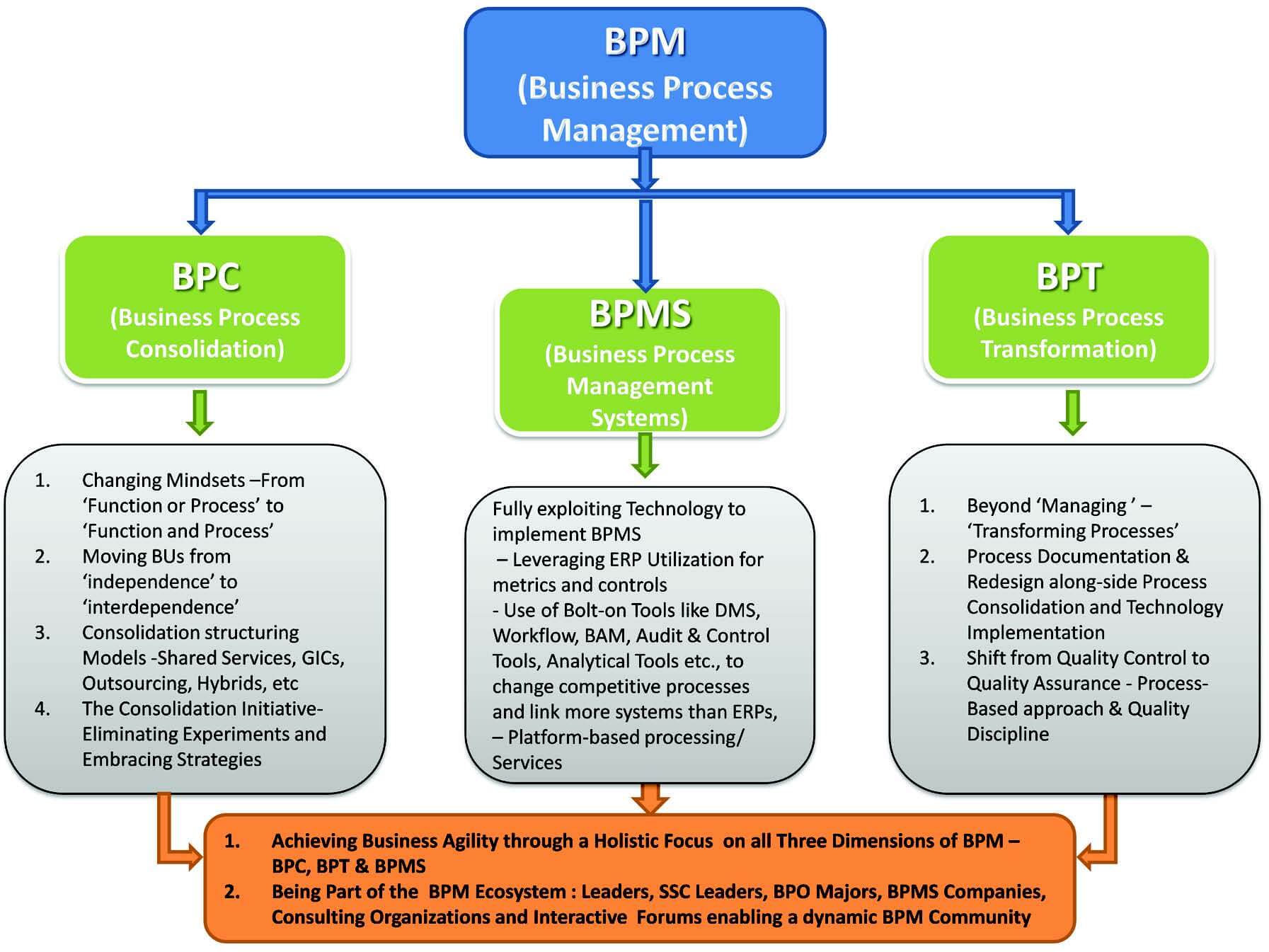
Would you like to start a conversation with other industry leaders to brainstorm a challenge or to just know more on a particular topic?
Engage in online discussions with your Peers
Start NowEven after the advent of Information Technology, in today’s business world, organization structures continue to be Function based – Sales, Production, Finance, Supply Chain or HR etc., and this has, by design, created the inevitable ‘silo culture’ in organizations, since the jobs and roles are defined accordingly. However, the leaders are quite aware that organizations create ‘value streams’ more from a ‘business process centric flow’ that cuts across various functions in an organization, to be able to reach goods or services to the end customer.
With TQM, Quality Revolutions and Automation in manufacturing/production functions, this transition has happened quite well in the shop floors, where production is organized as per processes for assembly line to ensure higher productivity and deliver maximum value. Hence, in today’s context, this shift from functional silos to business process centric flow is essentially applicable to Staff Functions in Manufacturing Industries and both Operations and Staff Functions in Service Industries. This shift assumes greater importance since Staff Functions, when converted into Service Functions, bring attention to adopt innovative approaches in these functions to create sustainable value in a fierce competitive environment.
Based on the experience of successful Indian and global organizations in reorganizing their staff functions/ service industries, there are possibly TEN axioms to make this happen:
-
Change in Mind-set - No Silo syndrome: Is there is a need to choose between focus on ‘Function or Process’? The answer is a clear No. This is not an ‘either/or’ question. Functional approach too has its own merits in organizational design and development! Hence, like for any other strategic initiative, this too surely calls for a change in the mind-set of functional and business leaders to adopt the ‘silos to streams’ approach. As Jim Collins puts it, it has to move away from the tyranny of the ‘or’ to embrace the genius of the ‘and’. Successful organizations have created the paradigm shift of ‘function AND process’, retaining the functional approach to focus on expertise and adopting the process centric approach to deliver value.
Organizations have found that even Centralization is not an option or a solution – since, it too becomes an extension of the functional approach and does not bring in the culture of process orientation. In order to break this silo syndrome, organizations have looked at each of the Staff/ Service Functions – be it, Finance, HR, Procurement, Marketing Services etc., and have identified certain processes to reorganize for consolidation to commence the process-oriented culture.
-
Decentralized Business & Process Consolidation:Decentralized Business Units are here to stay as the best way of combining accountability with empowerment to deliver results as per commitment. Having said, this approach should be made applicable only to business drivers, decision support areas and revenue generating engines of the Business Unit. This need not be extended too far, to day-to-day ‘rule-based’ operational activities and processes.
In other words, as Stephen R Covey puts it, the BUs will be benefited to move from a state of ‘independence’ to ‘interdependence’, and not perceive that this change as moving back towards ‘dependence’. There needs to be a coexistence of decentralized empowerment for the business as well as consolidation into ‘process-based’ operations or ‘shared services’ operations common to all Business Units, to free up the business leadership time to focus on real business issues and requirements. The Operations also should treat Business Units as Customers with service orientation, and not become ‘departments’ of corporate functions. This enables to bring the ‘line function’ focus to staff activities, with metrics to track, monitor and improve the processes.
-
Managing or Transforming Process Streams?Organizations adopting BPM have always used the term ‘management’ in BPM not as a limiting one, but consider inclusion of process improvements, redesign, reengineering, strategic initiatives and transformation! In fact, transforming business processes (Business Process Transformation - BPT) can be taken up even without or before any business process consolidation. Having said, quite often, organizations have shared that they start their focus on moving beyond functional management to BPM, only when Shared Services Operations are initiated.
-
Leveraging Technology: Information Technology has been the trigger for BPM to be adopted:be it offshoring, shared services, outsourcing or transformation. In a way, BPM is also referred to as IT Enabled Services (ITES) to convey that IT is the foundation for BPM. Hence, Organizations intend to fully leverage IT to get the best out of BPM. This takes several forms under the umbrella of Business Process Management Systems (BPMS) besides just ERPs, e.g. Bolt-on tools like Document Management System & Workflows, Audit & Control Tools, Platform based processing/ services, Analytical Tools etc.,
Despite this intention, there are challenges in leveraging Technology to the fullest since IT focus is more business facing (mostly production/ costing/ financial statements/ materials/ sales) and there is lack of focus on business processes that cut across functions. Even normal metrics like volume/ value of payables according to various transaction types is not readily available or the functionality is not activated in the ERP. In fact, even when ERPs exist, Companies use excel sheets extensively and sometimes, the number of excel sheets being used crosses 1000s. Also, we have seen a simultaneous use of more than one instance of the same ERP, to suit the needs of different businesses, although there need not have been, if thought through well.
Beyond ERPs, there are many reasons to use BPMS Tools. Companies would like to streamline interactions and workflows by overlaying ‘user-unfriendly’ ERP screens and workflows by new user interfaces and simple process orchestration. It enables to link elements of business processes that extend beyond the ERP to other systems like CRM/Vendor Portals, legacy systems etc., or require building a ‘differentiating’ revenue processes from ‘enquiry to cash’. Clearly, BPMS allows companies to change competitive processes quickly with no risk to core ERP systems.
When companies focus on BPM, they are required to get the best out of their current ERPs and make certain additional investments to bring value to the overall business process.
-
Going beyond Technology: Even when ERPs are implemented, organizations have noticed that there are several manual components that continue by design like physical movement of documents. On the other hand, there exists no proper updated process documentation even for ERP Systems implemented, leave alone the documentation for manual components.
One of the large Indian Diversified Groups with turnover in $billions, multiple locations and countries, commenced business transformation initiative in three parts at the time of implementing SAP – Process Documentation (both manual + system) across all functions, SAP Implementation itself, and consolidation of identified processes across functions like F&A, Procurement, HR etc., into a Shared Services Centre. This is an example of comprehensive transformation program of BPM, with multiple project streams.
-
Process Consolidation Options:Business Process Consolidation can take the form of many structuring models – Shared Services, Global In-house Captives (for offshoring), Outsourcing, Hybrid (combination of two models), Managed Services, Build Operate Transfer, Build Operate Manage etc., The choice of a structuring model that a Company would like to choose is specific to that organization – maturity of the processes, dealing with people redeployment requirements, degree of control at the hands of Business Units, scalability, single vs multiple functions, viable opportunity etc..
In the Indian environment, the process maturity – documentation, metrics, controls, etc., is low and hence, many of the Indian organizations choose Shared Services as an option, to mitigate the risks and experience success. The right structuring model is a critical decision to deploy BPM successfully.
-
Experiment or Strategy?This is one of the major issues we have observed in Indian Organizations! The Consolidation initiative – be it Shared Services or Third-Party Outsourcing, should never be seen as an experiment or even as a pilot, since this concept is industry proven and implementation success depends on how well project and change management is taken care of. All the more, since such initiatives impact the people, the continuity of focus and skilling is critical to success!
Typically, the number of resources for each staff function is quite limited and hence, if the operations were to become viable, one has to take a mid to longer term perspective, than a short-term view. The minimum is the strategy for one function at the least, while optimum is at least 2 functions to be included for strategic review at a very marginal increase in costs. The pioneering Survey of Shared Services in India states that F&A and HR processes are the two top functions that are considered as part of the strategy first, when organizations begin their journey of BPM.
-
Quality Control to Quality Assurance:Control is an essential ingredient of any functional activity to ensure that accuracy or timeliness is maintained. Invariably, whenever control happens ‘post’ an activity is completed, it is seen as a non-value adding component. However, when a process-based approach is adopted, this Control would gradually become Assurance, as it will be embedded in the process itself i.e. exercised ‘while’ processing and is an integral part of the process.
This QC to QA experience is clearly similar to manufacturing processes, where input control is exercised on any material received before production, while process control is built into the process. This shift to process-based approach enables lower levels of defects, yielding a higher level of sigma in terms of quality. In fact, the processes lend themselves to inculcate quality disciplines like application of Seven QC Tools, Six Sigma and Lean, to improve processes, productivity, performance and customer/employee experience.
The 10 axioms taken together create the ‘Transformation Highway’
for achieving excellence in execution of all BPM initiatives and is
well depicted in the figure below

-
Holistic Focus on BPM:The omnipresent reference guide Wikipedia well describes BPM as “a holistic management approach to aligning an organization’s business processes with the wants and needs of clients, using a systematic approach in an attempt to continuously improve business effectiveness and efficiency, while striving for innovation, flexibility, and integration with technology”.
In order to achieve this overall business agility, based on the guide on ‘BPM in Global India – The Inflection Point for Competitive Advantage’, BPM can be summarized as containing three major components – Business Process Consolidation (BPC), Business Process Transformation (BPT) and Business Process Management Systems (BPMS). The various axioms shared above will fall into any of these three components and it is imperative that this simple, yet holistic approach has yielded significant benefits to organizations.
-
Be Part of the BPM ecosystem:The BPM ecosystem consists of business leaders who share their expectations and insights as key customers, Delivery leaders who run BPM operations, BPO corporations whose main business is BPM, Organizations providing BPM systems and tools, niche BPM consulting organizations and a community platform that links, networks and enables sharing of knowledge, best practices and success stories.
Successful organizations in BPM become part of such an ecosystem to build an on-going repository of information to draw upon as and when there is a need for their understanding and implementation.
All the above axioms of BPM taken together become the overarching umbrella for BPM. They have the power to unlock the true value potential from staff functions and build rigor that can become can help achieve competitive advantage, process agility and cost optimization.




